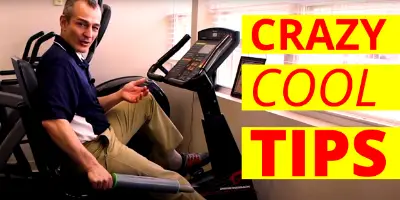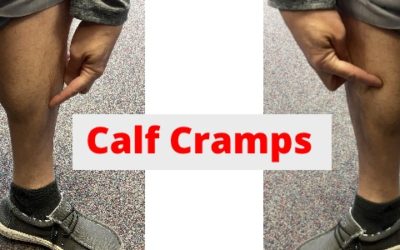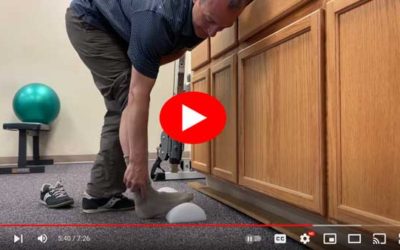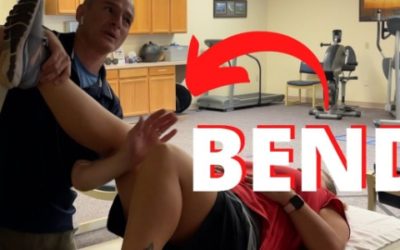How To Use A Stationary Bike After A Total Knee Replacement
An exercise bike is an excellent option after knee replacement surgery.
The adjustable seat and variable resistance can make it the perfect tool for increasing range of motion, improving endurance, and getting you back to the active lifestyle you enjoy.
Lightly used exercise bikes can be purchased on eBay and Facebook marketplace as well as second-hand retailers like Play It Again Sports.
New bikes may be purchased on Amazon or other sports retailers.
If possible, it is recommended that you purchase your bike before surgery in order to get a feel for riding it.
Top 4 Best Type of Exercise Bike To Rehab Knee
1.) Recumbent Bike
Recumbent bikes are the most popular bikes used in rehab for post-surgical care following a total knee replacement.
These bikes are most easily identifiable by the large seat and backrest.
If you would like more information about recumbent bikes and how to pick the best one for total knee replacement rehab check out this article.
2.) Upright Stationary Bike
An upright stationary bike has a seat positioned higher than the pedals and usually more over the pedals than a recumbent bike.
3.) Airdyne Bike
Although Airdyne is a model and not a type of bike, it deserves its own category.
The Schwinn Airdyne has been a classic bike for decades. Made of mostly all steel, this workhorse in the gym almost never breaks down and has helped countless individuals build strength and endurance but leveraging the power of the wind.
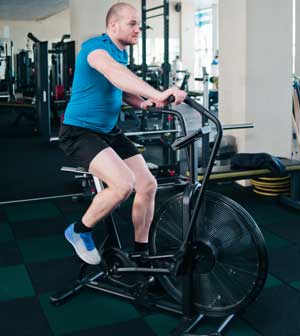
4.) Spinning Bike
A spinning bike has been popularized by spinning classes. This stationary bike is similar to a classic road bike. It has a small seat and positions the rider in more of a forward-leaning position. This bike is great for speed and endurance and is preferred by endurance athletes over recreational cyclists.
What Is A Recumbent Exercise Bike?
A recumbent bike is a type of stationary bike that has a larger seat with a full-length backrest.
It is often recommended for individuals with low back pain attributed to spinal stenosis.
It is differentiated from an upright, stationary bike because the pedals are positioned in front of the pelvis and the body is in a more reclined position.
Can I Do Too Much Exercise After Knee Replacement?
Absolutely YES!
Your body is no different than an Olympic athlete’s body. You need rest and recovery as much as you need exercise.
After a total knee replacement, your body has experienced a tremendous amount of trauma.
The pain levels are high which increases your stress hormones.
You aren’t sleeping very well which slows down your tissue healing.
And the emotional stress levels are usually through the roof so all of this makes for a challenging time for your body to recover.
During the first two weeks, you should get plenty of sleep, great nutrition, and focus on healing/recovery.
During the next three to six weeks your stamina will improve and your ability to move will skyrocket.
Finally, after 6 weeks the surgical incision will be healed and you will be ready to really start to increase the frequency and intensity of exercise.
Is A Bike Good For Limited Knee Flexion?
Yes! A bike is great for limited knee flexion if you want to improve your knee flexion.
An upright stationary bike is usually preferred over a recumbent bike because it required less knee flexion initially.
As your range of motion improves you may choose to move your seat closer to the pedals to continue to increase knee flexion.
How Much Knee Flexion Will I Need During Cycling?
This depends on the kind of bike you choose. A general rule of thumb is about 90 degrees of flexion to complete a full revolution. If you move the seat closer to the pedals you will need more.
If you cheat a bit and move your seat further away from the pedals you may complete a revolution with less knee flexion.
Next, as your range of motion improves you would move the seat closer to a more normalized position.
How Much Pain Can I Expect After A Total Knee Replacement (TKR)?
A total knee replacement is often considered more painful than a total hip replacement.
The first 24-48 hours after the procedure your anesthesia from the surgery will help manage the initial pain response.
Follow your surgeon’s guidance for dosing your medication, but many clients will say after the first 48 hours the pain may intensify but should always be manageable.
The pain should never reach the point of agony. A pain level of 7 out of 10 on the Mankoski Pain Scale is described as “Makes it difficult to concentrate, interferes with sleep. You can still function with effort. Stronger painkillers are only partially effective.”
If your pain levels reach a 7 it is recommended you contact your surgical team.
Can I Have A Knee Replacement Without Doing Physical Therapy?
Yes! The trend has been toward less physical therapy for individuals who do not have complications following a total knee replacement.
As a physical therapist myself, I would rather a client receive a couple of physical therapy sessions before surgery to better prepare for what is to come, than do less follow-up therapy as long you are progressing normally.
Is An Exercise Bike Good For Knees?
Yes, an exercise bike can be great for your knees. But so can lots of other exercise equipment.
The best piece of exercise equipment is the one you know you will enjoy.
I have worked with clients who use a treadmill every day and others who use a treadmill to hang clothes.
Is An Airdyne Bike Good For Knee Rehab?
One of my favorite exercise bikes is the Schwinn Airdyne. The ability to use the arms and legs in combination or just the arms or just the legs is a huge benefit.
The steel body of the bike also makes it last for a long time without the risk of breakdown.
I have seen these bikes resell on Craigslist and eBay for top dollar simply because they age so well.
Can I Use A Treadmill After Knee Replacement Surgery?
Yes, a treadmill can be a wonderful addition to a total knee replacement recovery program.
The treadmill offers a clean, flat, well-lighted surface to walk on.
Since you are probably a human being reading this post, you likely move through space on two feet. A treadmill is one of the most functional pieces of training equipment that allow you to weight-bear and walk the way you would in the community.

Anthony Maritato, PT
Physical Therapist
Anthony Maritato, PT has been a licensed physical therapist and private practice owner since 2006. Ohio license #PT011602.
Anthony has been passionate about helping patients recover from total knee replacement surgery as well as rotator cuff repair surgery.
More Blog Posts …
Knee Pain 1 Year After Knee Replacement Surgery
Nearly 20% of patients who have undergone total knee replacement are not happy with the outcome. [1] Dr. Scott Albright, MD. Dr. Albright is a non-surgical orthopedic specialist and in my opion one of the best sports medicine doctors in Middletown, Ohio. He has...
Is a recumbent bike good for knee replacement?
Riding a recumbent bike after a total knee replacement can be a great way to increase range of motion, increase cardiorespiratory fitness, and improve overall well being. In this video I explain some tips and tricks we use in the clinic to help clients maximize the benefit of riding this bike.
Calf Cramps How to STOP Calf Cramps
How to Stop Calf Cramps at Night When They are Happening One of the must frustrating times to get a calf cramp is in the middle of the night. You may be sound asleep when all of a sudden you experience this intense shooting pain which causes you to draw up in writhing...
3 TIPS to STOP Ankle Pain After Knee Replacement Surgery
Ankle pain after total knee replacement surgery is very common. Osteoarthritis of the knee causes the knee to change shape over time. The knee replacement surgery will correct any malalignment of the knee, but it causes excessive stress on the ankle and hip. In this...
Is a Manipulation Under Anesthesia MUA Painful
No, during a manipulation under anesthresia after a total knee replacement you will be placed under sedation and the procedure is painless. During the following 24 to 48-hours you may feel some increased soreness and swelling, but very few patients actually reqort...
Recovery After MUA Manipulation Under Anesthesia [VIDEO]
Video SeriesAnthony Maritato, PT has been a licensed physical therapist and private practice owner since 2006. Ohio license #PT011602. Anthony has been passionate about helping patients recover from total knee replacement surgery as well as rotator cuff repair surgery.
Hip and Groin Pain After Total Knee Replacement Surgery
I couldn't find peer-reviewed data to support an answer to this question, but as a physical therapist with 20 years of history in the clinic, I can tell you that anterior hip and groin pain after a total knee replacement is not uncommon. As of writing this article on...
How Painful Is A Total Knee Replacement
How long does the pain last after a knee replacement? * How bad is the pain after knee replacement surgery? * Why is a knee replacement so painful? * What helps pain after a total knee replacement?
2 Reasons why your knee replacement sounds like Velcro tearing!
The two reasons why your total knee replacement sounds like Velcro tearing when standing up from a chair or walking downstairs are because the underside of your patella is rubbing against the bottom of your femur or you are experiencing the sensation of scar tissue...
When can I switch from a walker to a cane?
Between 10 and 14 days after total knee replacement surgery, most patients have switched from a walker to a cane. Of course, some patients never use a cane and just progress from the walker to no assistive device after a couple of days, while other patients depend on...
